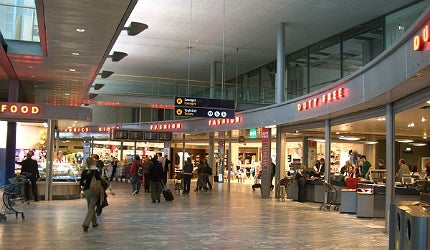
Despite all the advanced technologies deployed by the aviation industry over the last ten years to improve the passenger experience, for many travellers airports are still synonymous with stress, delays and snaking queues.
While new equipment can help airports cope with the unpredictable rigours of day-to-day operations, another idea is approaching the problem from an altogether more radical angle. Massive advances in artificial intelligence in recent years have opened the door to a new kind of airport; one which can think for itself.
Sophisticated digital ‘brains’ have the raw processing power to analyse thousands of data sources, using machine-learning principles and complex algorithms to make correlations between diverse sets of information. Airports still haven’t fully unlocked the potential of this kind of technology, but in an industry where it’s vital to understand the chaotic movements of huge groups of people, could artificial intelligence hold the key to airports that automatically evaluate passenger flow and even predict the flows of tomorrow – or six months down the line?
It might sound far-fetched, but a predictive AI system has now been developed that promises to accomplish exactly that. Although it is currently only being tested on a relatively small scale, this pioneering project could point the way to the semi-sentient airport of the future. With the revolutionary potential of advanced computers and software already firmly established, the implementation of these prophetic programmes might be restricted only by a shortage of cash and confidence.
Ready for take-off: taking AI from the lab to the terminal
Q-Alert is a predictive, AI-based software tool developed by VenueSim, a spin-out from De Montfort University (DMU) in Leicester, UK. The software, which has now been made commercially available with the help of venture capital group Lachesis, grew out of algorithms that DMU’s Professor Mario Gongora developed to help a colleague model the movement of ancient populations based on DNA spread.
"After a while, it clicked that we could also apply it on a smaller scale to how people move around in very large venues, using the final data," explains Gongora, who is also VenueSim’s chief technology officer. Gongora notes that the modelling software was particularly suited to large transportation hubs such as airports, where large groups of passengers need to be tracked without the use of CCTV monitoring or other privacy-infringing techniques. "We take where they started, the first starting point, and then where they ended up, which is the end of the process," he says.
How well do you really know your competitors?
Access the most comprehensive Company Profiles on the market, powered by GlobalData. Save hours of research. Gain competitive edge.

Thank you!
Your download email will arrive shortly
Not ready to buy yet? Download a free sample
We are confident about the unique quality of our Company Profiles. However, we want you to make the most beneficial decision for your business, so we offer a free sample that you can download by submitting the below form
By GlobalData"Then we use algorithms to try and find out what happened in the middle, without having to follow anyone individually."
Funding from Lachesis allowed VenueSim to work on bringing the technology to the commercial market, with user-friendliness and an industry relevance that its academic counterparts lacked. "It’s efficient," Gongora claims.
"It’s able to take real-world data – we don’t have to clean the data or change it to a funny format, like you do with academic research. It takes the real data in any format the industry uses. Then it’s able to show it in a user-friendly and useful way."
A prototype of the system was initially developed in conjunction with Birmingham Airport, a step which Gongora says was very helpful in providing data and industry knowledge. However, East Midlands Airport, which primarily serves the cities of Leicester, Nottingham and Derby, was the first airport to fully come onboard, and is currently trialling the software as part of its daily operations.
A unified view of passenger flows – present and future

In the end, it’s the prospect of improving the financial bottom line in the process that will likely be the key to this technology’s future success.
Gongora notes that airports generally collect huge amounts of data on passenger movements through various points in the terminal. The problem, he explains, is that this data is often not leveraged because of time constraints and communication problems between different areas of the airport.
"Q-Alert takes all this data, it brings together any source of data that the airport has, and it analyses it all as a single process," he says.
Related feature
Airport baggage systems go high-tech: handling with care
Airports are using increasingly sophisticated technology to streamline every aspect of baggage handling processes. Chris Lo rounds up the high-tech baggage handling trends which are simplifying this troublesome task for airlines and their customers.
"Then, it finds correlations between all of them, together as a single holistic process. Therefore, it can correlate things that normally don’t talk to each other, and it can correlate large amounts of data where it is normally very difficult to find how they relate to each other."
The most important benefit of Q-Alert’s ability to find correlations across a wide range of data is the models it creates to make short and long-term predictions about an airport’s passenger demand, which Gongora says are 95% accurate. By collecting data ranging from ticket sales and flight schedules to the number of cars parked and public transport timetables, as well as counting passengers as they cross points like the airport entrance and the security area, the system can predict the intensity of passenger flow.
These models can either provide airports with a minute-to-minute analysis of a particular working day, or on the other end of the scale, predict passenger flows months in advance.
"For instance, in February, they would already have information up to the end of the summer season in the following October," notes Gongora. "So that’s over half a year in advance."
Cashing in: benefits for retail, as well as passengers
Having this level of advance insight into incoming passengers (the system is mainly indicated for use in the departures process) has many applications, security being chief among them. As a well-known passenger bottleneck, the security area often sets a stressful tone for passengers just beginning their journeys. With a predictive software tool, it’s possible to react to a passenger influx before a queue can even begin.
Related feature
Brazil’s airport expansions: ready for take-off?
In the run-up to two major sporting events, Brazil’s airports are undergoing their biggest makeover in history. Elisabeth Fischer reports on the expansion process ahead of the 2014 World Cup and 2016 Olympic Games.
"In East Midlands, for example, from the different datasets that we analyse in real-time of people arriving at the airport, we can give a warning of between 45 minutes and one hour of extra traffic they will have in security," Gongora says.
"So now, instead of noticing that a queue is forming and working out how they can purge it, we can tell them that in half an hour or 45 minutes, a queue will form. Instead of having to purge the queue once they notice it, they can prepare in advance and see if they can do something to stop it forming, which is much easier."
As well as improving the smoothness of the security process, systems like Q-Alert could also have a significant effect on retail operations, a key source of revenue for any modern airport. On one level, reducing time spent queuing at security gives passengers more time to browse around a terminal’s shopping area. Indeed, VenueSim has cited estimates that airports lose 34 pence in profit for every ten minutes a passenger spends queuing at security. If that’s true, there’s an awful lot of money to be made by expediting an airport’s security checkpoints.
Gongora notes that East Midlands is also giving retail managers access to VenueSim’s models (only retail-relevant data, of course – the system can grant its users different levels of access) so that they can tailor their offerings to the types and numbers of passengers moving through security.
"[Shops] will also have information about the dwell time of people in the retail area," says Gongora. "So they’ll know the outlets that are going to be more popular at any given moment.
"If they know that half of the people are just waiting 15 minutes, it’ll be things like fast food and coffee shops and other types of shops that will be interesting for those people. If you know people are waiting longer, you can then prioritise the other type of shops in which you need a bit more time to browse around."
Data webs and predicting the future
Q-Alert might be able to predict future passenger flows, but Gongora has some ambitious plans for the future of the system itself. In essence, he wants to push Q-Alert’s area of data collection ever further from the terminal itself to provide earlier and more accurate analyses, creating an enterprise-wide spider’s web of data collection. This includes factoring in arrivals as well as departures, extra terminals and better information on incoming public transport passengers, and even data from local taxi stands.
From another angle, there’s a whole new world of information on the other side of the terminal building – flight movements on an airport’s aprons, taxiways and runways. "We have a teaming agreement with Northrop Grumman, and they have a division in the UK called Park Air," Gongora adds. "They want to create a complete airport collaboration software, which will also connect to an equivalent of the VenueSim system on the tarmac.
"Software that will do something similar to VenueSim but with the landing and take-off of planes, including control tower information. We can integrate the airfield and airport operations under a higher-level system that will manage the policies and regulations. With that, you can have a system that helps the process from the moment a plane is in the air to the moment a person drives away from the airport – or vice versa."
No airports other than East Midlands have currently approved a trial of Q-Alert, although Gongora optimistically thinks that every airport that has seen the system has expressed an interest. "The problem is, airports are living in the age of financial challenges and always being busy," he says. "They are always fire-fighting with problems everywhere. So there’s this cycle in which they’re too busy to step back, have a break and install VenueSim."
If and when airports reach a point where they can stop fighting fires and take a step back, they might start to seriously consider a predictive system that has the potential to put out fires before they even start. But in the end, it’s the prospect of improving the financial bottom line in the process that will likely be the key to this technology’s future success.




